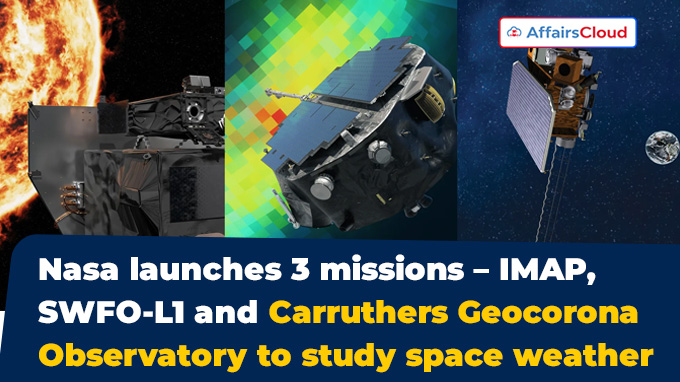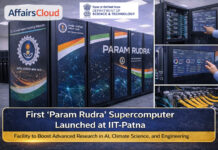On September 24, 2025, National Aeronautics and Space Administration (NASA), in collaboration with National Oceanic and Atmospheric Administration (NOAA), launched three missions such as Interstellar Mapping and Acceleration Probe (IMAP), Space Weather Follow-On-Lagrange 1 (SWFO-L1), and Carruthers Geocorona Observatory (CGO), to study space weather and its effects on Earth and space-based technologies.
- The missions were launched aboard a SpaceX Falcon 9 Rocket from Kennedy Space Center in Florida, the United States of America (USA).
Exam Hints:
- What? Launch of 3 missions
- By: NASA with NoAA
- Missions: IMAP, SWFO-L1, Carruthers Geocorona Observatory
- Where? From Kennedy Space Center in Florida (USA)
- Purpose: To study space weather and its effects on earth and space-based technologies
- IMAP: To study the boundary of the heliosphere
- SWFO-L1: To monitor solar wind and CMEs in real time
- CGO: To study Earth’s Exosphere
About Space Science Missions:
Interstellar Mapping and Acceleration Probe (IMAP):
Overview: IMAP, worth approximately USD 600 million, is a heliophysics mission, designed to study the boundary of the heliosphere, the protective magnetic bubble around the solar system created by the solar wind, and the interaction between the solar wind and the interstellar medium.
Objective: Its primary objectives are to map the heliospheric boundary, where the Sun’s influence ends and interstellar space begins, to track energetic particles in the solar wind and from beyond the solar system, and to understand the solar acceleration processes.
Operations & Instruments: IMAP will operate from a halo orbit around the Sun-Earth Lagrange point(L1 point), 1.6 million Kilometre (km) from earth. It allows continuous observation of solar wind and incoming interstellar particles without interference from earth’s magnetic field.
- IMAP carries 10 advanced scientific instruments for detecting energetic particles, solar wind, and magnetic fields.
Significance: The data from the IMAP will improve space weather forecasting, help protect satellites and astronauts, and advance the understanding of Sun’s influence on the solar system.
- IMAP can deliver an approximately 30-minute advance alert of incoming radiation to safeguard astronauts and spacecraft.
Space Weather Follow-On-Lagrange 1 (SWFO-L1):
Overview: SWFO-L1, operated by NOAA, monitors space weather in real-time to protect earth’s technological systems and astronauts in space.
Position: It is positioned at the Sun-Earth L1 point, approximately 1.5 km from earth, allowing it to observe solar wind and Coronal Mass Ejections (CME) before they reach Earth, providing critical lead time for space weather forecasting.
Aim: SWFO-L1 aims to monitor solar wind and CMEs in real time and provide early warnings for space weather events that could impact satellites, power grids, and communication systems.
- It also aims to ensure continuity of space weather observations, replacing aging satellites such as Solar and Heliospheric Observatory (SOHO).
Instruments: The satellite is equipped with Solar Wind Instrument Suite (SWIS), Magnetometer, Solar Wind Plasma Sensor (SWiPS), and Compact Coronagraph (CCOR).
Significance: It enhances the ability of NOAA to forecast space weather, providing data to protect infrastructure and support space exploration missions.
Carruthers Geocorona Observatory (CGO):
Overview: CGO is the first mission dedicated to studying earth’s exosphere, the outermost layer of the earth’s atmosphere, by observing the Ultraviolet (UV) light emitted by neutral hydrogen atoms.
Name Significance: The mission is named in honour of Dr. George R. Carruthers, a pioneering scientist and inventor. In 1972, he developed the first telescope to observe UV light from the Moon during the Apollo 16 mission, which laid foundation for modern space-based atmospheric studies.
Objectives: Its primary objective is to map the Geocorona, study the impacts of space weather, and investigate Hydrogen transport.
Instruments: It is equipped with two Far UV (FUV) Cameras such as Wide Field Imager (WFI) and Narrow Field Imager (NFI).
About National Aeronautics and Space Administration (NASA):
Administrator – Sean Duffy
Headquarters – Washington D.C, United States of America (USA)
Established – 1958





